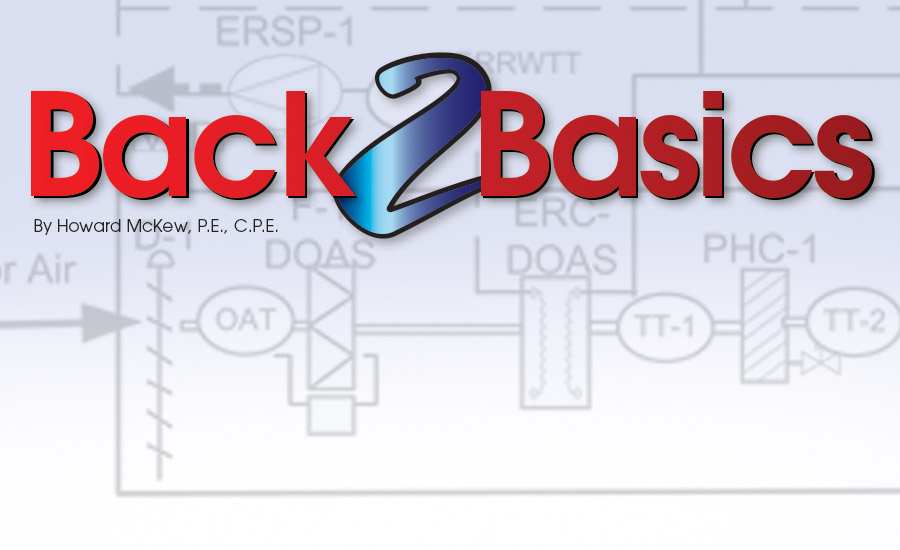This month’s B2B will focus on a 1,000-kW cogeneration unit with hot water energy recovery to a domestic hot water and process heating system on an existing health care campus. The pre-packaged cogeneration unit shall be located directly outside the central plant electrical room and connected to the existing electrical system. This unit’s heat exchanger (50 percent energy recovery) will be distributed underground in pre-insulated cold water-in and hot water-out pipes to the mechanical equipment room, where it will be connected to the central plant’s process heating system and the domestic hot water heating system via plate and frame heat exchangers.
The project delivery method shall be integrated project delivery (IPD) based on 2015 ASHRAE Handbook — HVAC Applications, Chapter 58 (Integrated Building Design). The IPD team shall include the health care system owner; building facility manager; owner representative; third-party commissioning and air and water balancing (CxTAB) consultant; HVAC consultant engineer as the design team leader; structural, plumbing, and electrical consulting engineers; and a general contractor and pre-qualified hospital-purchased cogeneration equipment manufacturer. The building’s facility manager and her O&M staff will also participate in the IPD process beginning at the conceptual phase along with the hospital’s third-party infection control commissioning consultant.
The design engineer, as well as the IPD team, is directed to ASHRAE 2016 — HVAC Systems and Equipment Handbook, Chapter 7 (Combined Heat and Power Systems). In addition, the hospital has chosen to follow the ISO 26382.2010 Cogeneration Systems — Technical Declarations for Planning, Evaluation, and Procurement. This IPD team will also review 2015 ASHRAE Handbook — HVAC Applications, Chapter 8 (Healthcare Facilities), Chapters 36-43 (Building Operation and Management), and Chapter 59 (HVAC Security).
Prior to the IPD team formation, the hospital and the design team will complete a technical-financial evaluation working closely with the local utility company. Design considerations will include completing an acoustic/sound study evaluating sound levels in the vicinity of the cogeneration unit.
The cogeneration unit shall be self-contained, pre-piped, and pre-wired with termination points at the exterior, acoustical wall panels. Pipes within the enclosure will be insulated, and a package ventilation system will also be located within the unit. An insulated muffler with exhaust pipe shall terminate outside after extending across the roof.
A cogeneration electrical panel and associated control panel shall be located within the enclosure with an additional control panel to accommodate electrical and building automation interfaces. A BACnet/internet interface shall also be included with this packaged unit. Once installed at the hospital, a commissioning test will be completed that will include the new heat exchanger systems serving the hospital’s process heat and domestic hot water heating systems.
The automatic temperature-control system shall include several monitoring features, including pertinent electrical power points, cogeneration room temperature, energy recovery cold water and hot water temperatures, process heat return and supply water temperatures, and domestic hot water entering and leaving the heat exchanger temperatures.
The IPD team shall begin to come together at phase two (Project Initiative) and include the owner, facility manager, owner representative, design team, third-party consultants, and general contractor. The remaining IPD team members will be brought on board at phase three (Concept Development) e.g., HVAC subcontractor.
The IPD team shall produce concept documents and design documents (drawings and specifications). Phases five (Construction Preparation), six (Construction), seven (Owner Acceptance), and eight (Use, Operate, and Maintain) shall follow. The IPD team shall complete an energy water recovery system balancing/performance working closely with the third-party CxTAB consultant. The O&M personnel shall review the documents beginning with the concept development phase and observe equipment start-up, ventilation air and water balancing, commissioning system demonstration, and commissioning of infection control policy and procedure.
The IPD team’s general contractor shall include the following during the shop drawing submittal phase:
- Equipment submittals - Pump curves - Piping field fabrication drawings – Start-up sheet - Troubleshooting sheets - O&M manuals, parts, and lubricants - ATC and energy management submittal, including one complete ATC submittal integrating manufacturer’s controls with outside the cogeneration unit ATC into an integrated overall ATC submittal.
The IPD third-party commissioning and testing, adjusting, & balancing (CxTAB) services:
-
TAB system flow diagram of the entire supply and return water systems with GPMs and head pressure readings indicated at each piece of equipment (cogeneration heat exchanger, process heat exchanger, domestic hot water heat exchanger, pumps) and at each component e.g., pressure drop across control valves and strainers.
-
Commissioning functional performance test of electrical power system interface, energy recovery system to the building systems, and the cogeneration ventilation and radiator ventilation system.
Refer to The Facility File for additional information pertaining to completing the B2B test. ES




